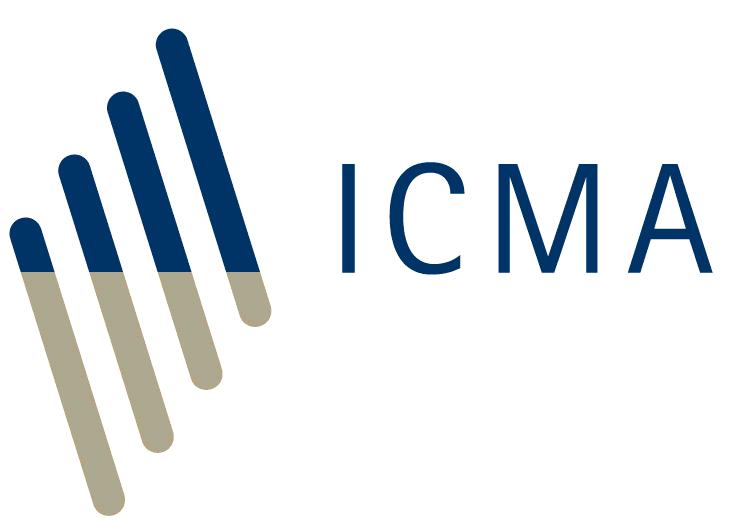ICMA publishes its semi-annual report that provides detailed data on EU and UK corporate bond market trading activity
April 2025
 ICMA’s Secondary Market Practices Committee (SMPC) has published its semi-annual report that provides detailed data on EU and UK corporate bond market trading activity.
ICMA’s Secondary Market Practices Committee (SMPC) has published its semi-annual report that provides detailed data on EU and UK corporate bond market trading activity.
Previous versions of this report included both corporate and sovereign analysis. Following readers’ input and feedback, the report is now published in two different editions:
- A corporate edition (this report)
- A sovereign edition (released 21 March)
One of the core objectives of MiFID II/MiFIR was to provide greater public transparency of secondary trading activity
It is estimated that the report captures more than 80% of all secondary bond market transactions reported in the EU and UK and is therefore relatively representative of the aggregated bond market data as reported under the MiFID II/MiFIR obligation.
This report, which follows the report published for H1 2024, provides 36 months of bond market data, covering the period January 2022 through to December 2024. ICMA believes that this latest data set provides a more accurate representation than the previous report.
ICMA commits to updating this report on a semi-annual basis in order to be able to track long-term trends in secondary bond market structure and activity. ICMA also expects that in time both the depth and quality of the underlying data will improve, particularly as reports such as this seek to present a definitive picture of the European bond markets.
ICMA publishes its semi-annual report that provides detailed data on EU and UK sovereign bond market trading activity
March 2025
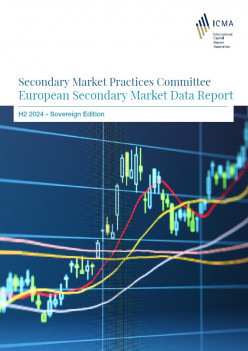 ICMA’s Secondary Market Practices Committee (SMPC) has published its semi-annual report that provides detailed data on EU and UK sovereign bond market trading activity.
ICMA’s Secondary Market Practices Committee (SMPC) has published its semi-annual report that provides detailed data on EU and UK sovereign bond market trading activity.
Previous versions of this report included both sovereign and corporate analysis. Following readers’ input and feedback, the report will now be published in two different editions:
- A sovereign edition (this report)
- A corporate edition (to follow)
One of the core objectives of MiFID II/MiFIR was to provide greater public transparency of secondary trading activity in the EU and UK markets. As solutions have evolved to consolidate the disperse sources of public data, ICMA has sought to leverage the capabilities of such initiatives to provide a detailed and holistic view of bond market activity in the EU and UK.
It is estimated that the report captures more than 80% of all secondary bond market transactions reported in the EU and UK and is therefore relatively representative of the aggregated bond market data as reported under the MiFID II/MiFIR obligation.
This report, which follows the report published for H1 2024, provides 36 months of bond market data, covering the period January 2022 through to December 2024. ICMA believes that this latest data set provides a more accurate representation than the previous report.
ICMA commits to updating this report on a semi-annual basis in order to be able to track long-term trends in secondary bond market structure and activity. ICMA also expects that in time both the depth and quality of the underlying data will improve, particularly as reports such as this seek to present a definitive picture of the European bond markets.
ICMA publishes its semi-annual report that provides detailed data on EU and UK corporate bond market trading activity
December 2024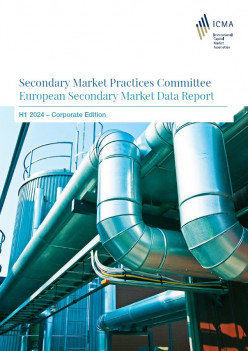 ICMA’s Secondary Market Practices Committee (SMPC) has published its semi-annual report that provides detailed data on EU and UK corporate bond market trading activity.
ICMA’s Secondary Market Practices Committee (SMPC) has published its semi-annual report that provides detailed data on EU and UK corporate bond market trading activity.
Previous versions of this report included both sovereign and corporate analysis. Following readers’ input and feedback, the report will now be published in two different editions:
- A corporate edition (this report)
- A sovereign edition (released 5 November)
One of the core objectives of MiFID II/MiFIR was to provide greater public transparency of secondary trading activity in the EU and UK markets. As solutions have evolved to consolidate the disperse sources of public data, ICMA has sought to leverage the capabilities of such initiatives to provide a detailed and holistic view of bond market activity in the EU and UK.
It is estimated that the report captures more than 80% of all secondary bond market transactions reported in the EU and UK and is therefore relatively representative of the aggregated bond market data as reported under the MiFID II/MiFIR obligation.
This report, which follows the report published for H2 2023, provides 30 months of bond market data, covering the period January 2022 through to June 2024. ICMA believes that this latest data set provides a more accurate representation than the previous report.
ICMA commits to updating this report on a semi-annual basis in order to be able to track long-term trends in secondary bond market structure and activity. ICMA also expects that in time both the depth and quality of the underlying data will improve, particularly as reports such as this seek to present a definitive picture of the European bond markets.
ICMA publishes its semi-annual report that provides detailed data on EU and UK sovereign bond market trading activity
November 2024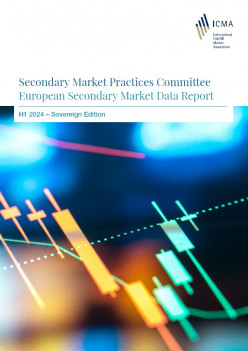 ICMA’s Secondary Market Practices Committee (SMPC) has published its semi-annual report that provides detailed data on EU and UK sovereign bond market trading activity.
ICMA’s Secondary Market Practices Committee (SMPC) has published its semi-annual report that provides detailed data on EU and UK sovereign bond market trading activity.
Previous versions of this report included both sovereign and corporate analysis. Following readers’ input and feedback, the report will now be published in two different editions:
- A sovereign edition (this report)
- A corporate edition (to follow)
One of the core objectives of MiFID II/MiFIR was to provide greater public transparency of secondary trading activity in the EU and UK markets. As solutions have evolved to consolidate the disperse sources of public data, ICMA has sought to leverage the capabilities of such initiatives to provide a detailed and holistic view of bond market activity in the EU and UK.
It is estimated that the report captures more than 80% of all secondary bond market transactions reported in the EU and UK and is therefore relatively representative of the aggregated bond market data as reported under the MiFID II/MiFIR obligation.
This report, which follows the report published for H2 2023, provides 30 months of bond market data, covering the period January 2022 through to June 2024. ICMA believes that this latest data set provides a more accurate representation than the previous report.
ICMA commits to updating this report on a semi-annual basis in order to be able to track long-term trends in secondary bond market structure and activity. ICMA also expects that in time both the depth and quality of the underlying data will improve, particularly as reports such as this seek to present a definitive picture of the European bond markets.
ICMA and Bloomberg publishes survey on reforms that are expected in KTB markets by global investors to boost interest and trading efficiency
July 2024New survey analysis of Korea Treasury Bonds (KTB) reveals significant untapped market potential for KTB trading. The survey, conducted by Bloomberg and the International Capital Market Association (ICMA), suggests that recent market reforms can generate increased interest in KTB trading.
The study surveyed more than 300 respondents within the global financial sector to assess the impact of existing reforms from a market stakeholder’s perspective and to understand market expectations of further reform initiatives in Korean capital markets.
The survey found that a staggering 91% of respondents had never engaged in KTB trading, indicating significant untapped market potential. While the majority of the respondents (88% of those who had never traded KTBs) do not have a clear plan to enter the market in the near term, the survey suggests that clearing with International Central Securities Depositories (ICSDs) and allowing KRW to be tradable offshore could be factors which drive them to consider entering the KTB markets. Only 3% of respondents said they currently traded KTBs, with only 6% having done so in the past. Consistent across all participant types, they traded KTBs mostly for portfolio diversification, however they experienced difficulties when trading KTBs offshore.
The survey noted that recent market reforms have sparked increased interest. Nearly half of the respondents expressed heightened interest due to latest operational reforms such as the “Simplified process for third-party onshore foreign exchange” (57%), the “Abolition of the Investment Registration Certificate” (47%) and “Omnibus account” (47%). Market participants also agreed that the likely impact of those measures will make KTB trading easier.
Furthermore, the anticipated use of the omnibus account for KTB trading has garnered significant attention, with 56% of respondents indicating plans to utilize this facility. This reflects a real demand for the omnibus account among market participants.
ICMA publishes the third semi-annual report that provides detailed data on EU and UK bond market trading activity
March 2024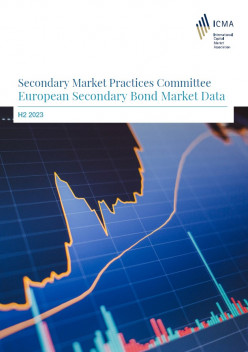 ICMA’s Secondary Market Practices Committee (SMPC) has published its fourth semi-annual report that provides detailed data on EU and UK bond market trading activity.
ICMA’s Secondary Market Practices Committee (SMPC) has published its fourth semi-annual report that provides detailed data on EU and UK bond market trading activity.
This report was produced in collaboration with Propellant.digital.
One of the core objectives of MiFID II/MiFIR was to provide greater public transparency of secondary trading activity in the EU and UK markets. As solutions have evolved to consolidate the disperse sources of public data, ICMA has sought to leverage the capabilities of such initiatives to provide a detailed and holistic view of bond market activity in the EU and UK.
It is estimated that the report captures more than 80% of all secondary bond market transactions reported in the EU and UK and is therefore relatively representative of the aggregated bond market data as reported under the MiFID II/MiFIR obligation.
This report, which follows the report published for H1 2023, provides an update after two years of bond market data, covering the period January 2022 through December 2023. Working with Propellant, ICMA believes that this latest data set provides a more accurate representation than the previous report.
ICMA commits to updating this report on a semi-annual basis in order to be able to track long-term trends in secondary bond market structure and activity. ICMA also expects that in time both the depth and quality of the underlying data will improve, particularly as reports such as this seek to present a definitive picture of the European bond markets.
ICMA publishes a new paper on liquidity and resilience in the core European sovereign bond markets
March 2024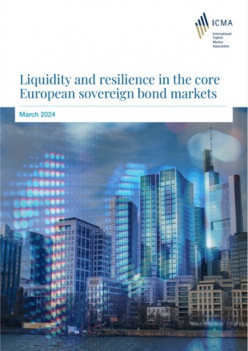 ICMA has published an in-depth analysis of liquidity and resilience in the core European sovereign bond markets.
ICMA has published an in-depth analysis of liquidity and resilience in the core European sovereign bond markets.
Using data analysis, modelling, as well as interviews with sell- side and buy-side market participants, the report attempts to identify potential vulnerabilities in underlying market structure.
Focused on the five largest European sovereign bond markets (Germany, France, Italy, Spain, and the UK), some of the key findings of the report are:
Liquidity in the core European bond markets is generally good, but in recent years liquidity has become much more sensitive to both episodes of unexpected volatility and regulatory reporting date.
The speed at which markets become volatile (the ‘volatility of volatility’) has increased.
Repo markets function well, even in times of heightened stress, but are also subject to sharp drops in liquidity around reporting dates.
Liquidity in the sovereign bond futures markets is generally good, although limited to a few contracts, and again prone to a rapid thinning and widening of prices in times of stress.
Market participants accept that episodic heightened volatility, with rapid evaporation of liquidity, and a sharp repricing of risk, is the new normal.
Participants also believe that central banks will be required to intervene in bond markets more frequently and systematically to restore stability.
The consistent recommendation from market participants, both sell side and buy side, to make sovereign bond markets more resilient, is that policy makers and regulators should review the design and calibration of prudential regulation as it applies to primary dealers
The report is intended to be the first in a series of reports, part of ICMA’s Bond Market Liquidity Taskforce initiative, which will look at other key bond markets.
ICMA publishes the third semi-annual report that provides detailed data on EU and UK bond market trading activity
September 2023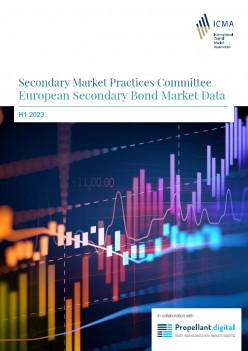 ICMA’s Secondary Market Practices Committee (SMPC) has published its third semi-annual report that provides detailed data on EU and UK bond market trading activity. This report was produced in collaboration with Propellant.digital.
ICMA’s Secondary Market Practices Committee (SMPC) has published its third semi-annual report that provides detailed data on EU and UK bond market trading activity. This report was produced in collaboration with Propellant.digital.
One of the core objectives of MiFID II/MiFIR was to provide greater public transparency of secondary trading activity in the EU and UK markets. As solutions have evolved to consolidate the disperse sources of public data, ICMA has sought to leverage the capabilities of such initiatives to provide a detailed and holistic view of bond market activity in the EU and UK.
The report captures more than 80% of all secondary bond market transactions reported in the EU and UK and is therefore relatively representative of the aggregated bond market data as reported under the MiFID II/MiFIR obligation.
This report, which follows the report published for H2 2023, provides an update after the first full year of bond market data, covering the period of January 2023 through June 2023. Working with Propellant, ICMA believes that this latest data set continues to build an accurate reflection than the previous report.
ICMA commits to updating this report on a semi-annual basis in order to be able to track long-term trends in secondary bond market structure and activity. ICMA also expects that in time both the depth and quality of the underlying data will improve, particularly as reports such as this seek to present a definitive picture of the European bond markets.
ICMA publishes the second semi-annual report that provides detailed data on EU and UK bond market trading activity
April 2023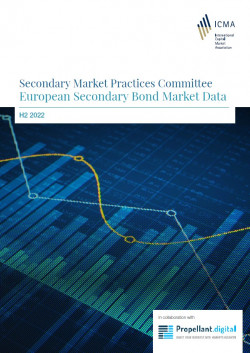 ICMA’s Secondary Market Practices Committee (SMPC) has published its second semi-annual report that provides detailed data on EU and UK bond market trading activity. This report was produced in collaboration with Propellant.digital.
ICMA’s Secondary Market Practices Committee (SMPC) has published its second semi-annual report that provides detailed data on EU and UK bond market trading activity. This report was produced in collaboration with Propellant.digital.
One of the core objectives of MiFID II/MiFIR was to provide greater public transparency of secondary trading activity in the EU and UK markets. As solutions have evolved to consolidate the disperse sources of public data, ICMA has sought to leverage the capabilities of such initiatives to provide a detailed and holistic view of bond market activity in the EU and UK.
The report captures more than 80% of all secondary bond market transactions reported in the EU and UK and is therefore relatively representative of the aggregated bond market data as reported under the MiFID II/MiFIR obligation.
This report, which follows the report published for H1 2022, provides the first full year of bond market data, covering the period of January through December 2022. Working with Propellant, ICMA believes that this latest data set is also a more accurate reflection than the previous report.
ICMA intends to update the report on a semi-annual basis in order to be able to track long-term trends in secondary bond market structure and activity. ICMA also expects that in time both the depth and quality of the underlying data will improve, particularly as reports such as this seek to present a definitive picture of the European bond markets.
ICMA publishes a third edition of the report Asian International Bond Markets: Developments and Trends
March 2023 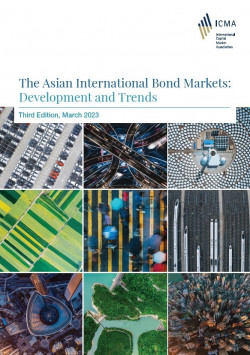 ICMA, supported by the Hong Kong Monetary Authority (HKMA), has today published the third edition of its report, The Asian International Bond Markets: Development and Trends. The report shows that annual issuance of cross-border bonds from Asia amounted to USD 346 billion in 2022. Despite a year-on-year decline in issuance volumes in tandem with the global market due to interest rate hikes by many central banks across the globe, geopolitical tensions, and sectoral credit events, certain market segments exhibited resilience and continued to fuel the growth of the international bond markets in Asia.
ICMA, supported by the Hong Kong Monetary Authority (HKMA), has today published the third edition of its report, The Asian International Bond Markets: Development and Trends. The report shows that annual issuance of cross-border bonds from Asia amounted to USD 346 billion in 2022. Despite a year-on-year decline in issuance volumes in tandem with the global market due to interest rate hikes by many central banks across the globe, geopolitical tensions, and sectoral credit events, certain market segments exhibited resilience and continued to fuel the growth of the international bond markets in Asia.
Download the report:
English version | Chinese version
Looking at markets across Asia including China, India, ASEAN, Japan and South Korea, the report identifies trends in both issuance and trading of international bonds in the region.
China accounted for 33% of Asia international issuance in 2022 and continued to be the largest overall source, followed by Japan and South Korea. International issuance volume by South Korean issuers remained relatively resilient compared with other jurisdictions, with USD 40 billion in 2022, only a 25% decrease from 2021.
Green, social, sustainability and sustainability-linked (GSSS) bonds also experienced a 22% decline in issuance to USD 80 billion during 2022, though as a proportion of all international issuance in Asia, GSSS bonds rose from 16% to 23%, evidencing the attractiveness of sustainable bonds as a financing instrument for issuers. The growth of international bond markets in Asia has been fuelled by the steady entry of new issuers and by a diverse investor base, with Asian financial centres playing a larger role in arrangement and listing.
As with the primary market, secondary market conditions were challenging in 2022, with overall traded volumes lower than 2021 and with regular episodes of illiquidity and heightened price volatility. These were in part a response to higher yields and widening credit spreads, which increased uncertainty for investors and risks for market-makers.
The use of electronic venues to transact in the secondary market continues to become more entrenched. Historically this has been mainly prompted by efficiencies, with most e-trading in smaller trade sizes and in more liquid, investment grade names. More recently, however, this increasingly has been driven by the need for price discovery and the search for liquidity. 2022 also saw a growth in the adoption of protocols other than RFQ, including all-to-all and portfolio trading.
Commenting on the report, ICMA Chief Executive Bryan Pascoe said: “While macroeconomic headwinds in 2022 have dampened issuance growth, Asian financial centres continue to play a significant role in the development of international bond markets. Indeed, beyond the headline numbers we see foundational work in the area of digitalisation that should drive strong growth”.
ICMA publishes the first semi-annual report on European Secondary Bond Market Data that covers EU and UK bond market trading activity
October 2022
ICMA has published the first semi-annual report on European Secondary Bond Market Data, providing detailed data on the EU and UK bond market trading landscape. The report was produced in collaboration with Propellant digitaI.
The report captures more than 80% of all secondary bond market transactions (both corporate bonds and sovereign bonds) reported in the EU and UK over the period January through June 2022. It is therefore relatively representative of the aggregated bond market data as reported under the MiFID II/MiFIR obligation. One of the core objectives of MiFID II/MiFIR was to provide greater public transparency of secondary trading activity in the EU and UK markets. As solutions have evolved to consolidate the disperse sources of public data, ICMA has sought to leverage the capabilities of such initiatives to provide a detailed and holistic view of bond market activity in the EU and UK.
ICMA intends to update the report on a semi-annual basis in order to be able to track long-term trends in secondary bond market structure and activity. ICMA also expects that in time both the depth and quality of the underlying data will improve, particularly as reports such as this seek to present a definitive picture of the European bond markets.
ICMA response to IOSCO discussion paper
July 2022
ICMA has submitted its response to the Corporate Bond Markets – Drivers of Liquidity During COVID-19 Induced Market Stresses, IOSCO discussion paper. ICMA’s response, drafted under the guidance of its Secondary Market Practices Committee (SMPC), is predominantly from a European market perspective and offers feedback and insights on a range of topics, including liquidity during the Covid-19 induced stress, the drivers of liquidity from both a demand and supply perspective, corporate bond market structure, dealer intermediation and concentration, corporate bond heterogeneity and standardisation, the growth of electronic trading and the effects of increased transparency.
AMCC publishes Report of the survey on corporate bond market microstructures and participant behaviours
17 January 2022
The AMCC report of the survey on corporate bond market microstructures and participant behaviour is an initiative of the IOSCO Affiliate Members Consultative Committee (AMCC) Bond Market Liquidity Working Party (BMLWP). While there are some gaps in the survey responses, the feedback may help in contributing to paint a picture of the different corporate bond market structures across key regional and national jurisdictions, as well as the market participant behaviours and drivers in times of market stress, drawing on the experience of the March-April 2020 turmoil. It concludes that that any interventions to help build market resilience should be focused on dealer capacity and incentives, rather than attempting to anticipate and influence the decisions and behaviours of an extremely diverse and complex universe of investors. ICMA, as Chair of the AMCC BMLWP, was actively involved in coordinating the survey and drafting the report. The report has been submitted to the IOSCO-FSEG Corporate Bond Market Liquidity Workstream, and is intended to complement and inform the second phase of its work.
AMCC Compendium of research on Covid-19 and corporate bond markets
May 2021
AMCC Bond Market Liquidity Working Party has submitted a compendium of member association research to IOSCO to complement its diagnostic work on how corporate bond markets performed during the Covid-19 turmoil. The BML WP consists of a number of national and international market associations (AIMA; ANBIMA; CCP-12; EFAMA; GFMA; ICI Global; ICMA; IIROC; and JSDA) and is chaired by ICMA. The WP hopes to continue to support and complement the ongoing work being undertaken by IOSCO (in coordination with the FSB) on global corporate bond market micro-structures.
Asian International Bond Markets – new report from ICMA
March 2021 The International Capital Market Association (ICMA) has today launched a new report on developments in Asian bond markets, supported by the Hong Kong Monetary Authority (HKMA).
The International Capital Market Association (ICMA) has today launched a new report on developments in Asian bond markets, supported by the Hong Kong Monetary Authority (HKMA).
Asian International Bond Markets: Development and Trends focuses on the international, offshore bond market in Asia, which is most easily accessible to international market participants. It looks at both primary and secondary markets, examining trends in issuance from China, India, ASEAN, and Japan as well as assessing the market structure and dynamics of bond trading in the region.
As domestic capital markets in Asia have matured, seasoned issuers have entered the international bond market in greater numbers, resulting in significant growth over the past 15 years. Issuance in the Asian international bond market amounted to USD 575 billion in 2020, a more than five-fold increase from 2006. However, cross-border issuance still accounts for only 20% of all the bond issuance in Asia, while 40% of global bond issuance is cross-border.
Martin Scheck, ICMA Chief Executive said: "Rising cross-border capital flows in Asian countries highlight the potential for a future pan-Asian bond market of a depth and size comparable with those of Europe and the US."
Much of this rapid development is due to Chinese issuers increasingly tapping the international bond markets. Recent years have also seen increasing issuance from countries where domestic markets have historically dominated, such as India and the ASEAN nations. Along with the growth of the markets, Asian financial centres and exchanges have also gained market share as the locations where cross-border bonds are arranged and listed, and Asian investors have become increasingly important in the primary distribution of Asian international bonds.
In secondary markets the report identifies an increase in the uptake of e-trading which has traditionally lagged behind US and European markets and a move to secondary market liquidity supply by a number of global banks that support flow trading on a pan Asian basis. Continuing illiquidity in the repo and securities lending markets limits the availability of financing for securities trading. However, sentiment remains positive, and investor demand for Asian bond issuance in the international market continues to grow.
The report draws upon extensive quantitative data from Bloomberg, Dealogic, EquiLend, IHS Markit and MarketAxess, as well as qualitative research and interviews with market participants.
ICMA responds to IOSCO survey on bond ETF in the context of March/April 2020 market meltdown
1 March 2021
ICMA has responded to IOSCO survey on bond ETF in the context of March/April 2020 market meltdown. ICMA’s response involved members representing issuers, investors and authorised participants and market makers. The recent crisis shows that overall the ETF ecosystem functioned well despite extreme circumstances but that there is a need to continue improving the resilience and liquidity of corporate bond markets via its further electronification and appropriately calibrated regulation.
The internationalization of the China corporate bond market
January 2021 Recognising the increasing importance of China in the global bond markets, and in light of significant reforms and initiatives to attract foreign investors, as well as the inclusion of China in major global bond indices, the International Capital Market Association (ICMA) has published a report focusing on the trends, opportunities, and challenges related to the internationalization of the China corporate bond market, both onshore and offshore.
Recognising the increasing importance of China in the global bond markets, and in light of significant reforms and initiatives to attract foreign investors, as well as the inclusion of China in major global bond indices, the International Capital Market Association (ICMA) has published a report focusing on the trends, opportunities, and challenges related to the internationalization of the China corporate bond market, both onshore and offshore.
China’s onshore bond market, at approximately $15 trillion equivalent of outstandings, is the second largest in the world, after the US. ICMA estimates the overall size of the outstanding onshore credit bond market to be approximately valued at $5.8 trillion of which $3.7 trillion is non-financial corporates and $2.1 trillion are financial bonds.
Market participants interviewed for the report indicate that one of the main motivations for investing in China’s corporate bond markets is the continuing strong economic backdrop and in the onshore market the relatively high nominal returns in comparison to global bond markets where yields are close to zero or negative. A major catalyst for foreign inflows into the onshore bond market since 2019, particularly passive investment flows, has been the inclusion of China in various global bond indices. Among the barriers to foreign investors entering the onshore market are challenges with assessing the credit quality of underlying corporates, which require investors to dedicate time and resources to their own proprietary credit analysis and the incidence and outcomes of corporate defaults. The lack of a liquid secondary bond market is also perceived as a major obstacle to internationalization of the onshore credit market.
ICMA estimates the size of the offshore China corporate bond market to be approximately $752 billion of equivalent nominal outstanding, or around 30% of the total APAC international corporate bond market and 38% of APAC international USD issuance, this issuance is skewed towards financials predominantly in real estate financing. Much of the impetus for Chinese corporates to tap the international debt markets is the result of China’s rapid global economic expansion, and the need to fund overseas investment and acquisitions, primarily in USD. The investor base in this market has diversified in recent years, with more regional and global asset managers looking to diversify their portfolios while seeking out higher returns.
Martin Scheck, ICMA Chief Executive said: “China is rapidly establishing itself as an important part of the global cross-border bond markets, and it is inevitable that the onshore credit market will increasingly attract interest from international investors”.
The report concludes that while there are multiple challenges for international investors who wish to enter the $5.8 trillion onshore credit market, that are likely to persist in the short-term, they are not insurmountable. The potential for transforming the China onshore credit market into a truly global market is significant.
ICMA discussion paper on Transparency and liquidity in the European bond markets 29 September 2020
29 September 2020
The state of liquidity in the European bond markets has been hotly debated for a number of years, with the growing realization that due to a culmination of factors market liquidity has been in serial decline for more than a decade. There is an ongoing parallel discussion on the issue of transparency in the European bond markets. While it is broadly recognized that a degree of price transparency is fundamental for market efficiency and integrity, the intersection of transparency and liquidity is a far more complex consideration, yet an important one from the perspective of market development.
ICMA has been at the forefront of industry work related to both bond market liquidity and the design and implementation of the European transparency framework for bonds. This paper attempts to pull those two workstreams together in order to explain how bond market structure and dynamics are very different to those of equity markets, that this is the basis for how liquidity is created in bond markets, and why this is central to any considerations around the framework for European bond market transparency, including any proposed future regulation related to the provision and design of a consolidated tape for bonds.
The European investment grade corporate bond secondary market & the COVID-19 crisis
May 2020 This report documents the performance of the investment grade secondary bond market in Europe during the last weeks of February through March and April 2020, as the COVID-19 pandemic caused levels of market volatility and dislocation surpassing those seen during the global financial crisis of 2007-2008. The report is based on market data as well as interviews and surveys of buy-side and sell-side market participants.
This report documents the performance of the investment grade secondary bond market in Europe during the last weeks of February through March and April 2020, as the COVID-19 pandemic caused levels of market volatility and dislocation surpassing those seen during the global financial crisis of 2007-2008. The report is based on market data as well as interviews and surveys of buy-side and sell-side market participants.
Among its findings, the report indicates that during the peak of the crisis, participants resorted to voice trading when the market became too volatile and too illiquid for dealers to risk providing pricing across electronic platforms. While many banks did continue providing liquidity and market-making via voice or messaging, overall dealer capacity appears to have shrunk at a time when it was needed most. Large trading volumes were however recorded through electronic platforms, using different trading protocols, for example processed trading where a price is agreed on the phone or messaging and then ‘consummated’ on a system.
There was a sizeable but temporary increase in settlement fails during the height of the crisis. This is largely attributed to the operational challenges of the relevant teams transitioning to remote-working at a time when overall trading volumes were significantly above average. This increase in structural settlement fails has accentuated concerns in the market about the EU’s CSDR mandatory buy-in provisions, due to come into force in early 2021, and raises questions as to how this would have impacted the market had it been in place during the COVID-19 turbulence.
Listen to Andy Hill's Podcast on the report.
Time to act: ICMA’s 3rd study on the state of the European investment grade corporate bond secondary market
March 2020 ICMA’s third study into the state and evolution of the European investment grade corporate bond secondary market. Based on quantitative market data, stakeholders surveys, as well as in interviews with market participants, the study looks at the current state of market liquidity; the evolution of market structure; and participants’ expectations for future developments in the market. It compares market conditions and developments since the previous 2016 study, as well as the 2017 reports of the European Commission’s Expert Group on Corporate Bond Markets.
ICMA’s third study into the state and evolution of the European investment grade corporate bond secondary market. Based on quantitative market data, stakeholders surveys, as well as in interviews with market participants, the study looks at the current state of market liquidity; the evolution of market structure; and participants’ expectations for future developments in the market. It compares market conditions and developments since the previous 2016 study, as well as the 2017 reports of the European Commission’s Expert Group on Corporate Bond Markets.
The study concludes that secondary market liquidity conditions remain challenged, and have deteriorated since 2016. It also examines the key trends and developments in market structure over the past three years, including evolving market behaviour and the adoption of new trading protocols, as well as the impacts of regulation and monetary policy. Looking forward, it identifies potential opportunities through new technologies and the use of data, as well as further challenges to liquidity, not least as a result of higher capital charges for market makers, as a result of the Fundamental Review of the Trading Book (FRTB), and the implementation of the Central Securities Depositories Regulation (CSDR) mandatory buy-in regime. The report encourages policy makers, regulators, and stakeholders to build on the work undertaken by the European Commission’s Expert Group in order to prevent further declines in market liquidity and to ensure the continued development of Europe’s corporate bond market.
The Asia-Pacific Cross-Corporate Bond Secondary Market - A report on the state and evolution of the market
August 2018ICMA has published a report on the state and evolution of the Asia-Pacific cross border corporate bond secondary market. While the report is primarily focused on G3 (USD, EUR, GBP) denominated bonds of non-financial and financial corporate issuers, as defined by having the issuer country of risk within the APAC region, it also explores the ongoing internationalisation of local currency markets, in particular the Chinese market.
The report highlights the rapid rise in issuance and the size of the G3 (in particular USD) corporate bond market since 2011, which has accelerated in the past two years driven primarily by Chinese financial and non-financial issuers coming to the market. From 2011 to 2017, annual G3 APAC corporate issuance has more than trebled to over USD 930bn, with Chinese names accounting for more than 40% of total issuance in 2017, compared with less than 20% in 2011. The report sets the size of the market at May 2018 at approximately 8,500 outstanding issues with a nominal value of almost USD 2.5 trillion.
The European Corporate Single Name Credit Default Swap Market - A study into the state and evolution of the European corporate SN-CDS market
February 2018
ICMA has published a report on the current state and evolution of the European corporate single name credit default (SN-CDS) market, focused on its benefits for liquid and efficient corporate bond markets.
The report is based on interviews with market participants, including buy-side users, as well as extensive data and quantitative analysis. It sets out to map the state of the market, establishing who are its main users and what benefits and risks are associated with the product. Concentrating on the European corporate SN-CDS market it looks at where and how liquidity is provided, and the related costs and challenges of the CDS product.
ICMA’s response to IOSCO’s consultation paper on Regulatory Reporting and Public Transparency in the Secondary Corporate Bond Markets
16 October 2017
ICMA’s response to the IOSCO consultation paper largely focuses on members’ concerns related to the imminent implementation of the MiFID II/R pre- and post-trade transparency regime and the potential implications for European secondary corporate bond market liquidity.
ICMA European Credit Repo Market Study
22 June 2017
ICMA publishes The European Credit Repo Market: The cornerstone of corporate bond market liquidity which explores and describes the state and evolution of the European corporate bond repo and securities lending market (the ‘credit repo market’). The study builds on ICMA’s previous work with respect to both corporate bond market and repo market evolution and liquidity, and investigates the European credit repo market from the perspective of its role, structure, participants, dynamics, external impacts, challenges, opportunities, and potential evolution, particularly to the extent that this plays a pivotal role in overall corporate bond market liquidity.
Times they are a-changin’: the corporate bond market liquidity conundrum and the changing buy-side paradigm
November 2016
While various market, authority, and academic studies and their conflicting conclusions continue to add more fuel to the fire of the liquidity debate, raising questions about the appropriate way to define and measure market liquidity, what becomes clear is that regardless of who might be right, buy-side firms are having to rethink their business models as they adapt to a rapidly evolving market environment, with very ‘different’ liquidity conditions. This article by ICMA’s Andy Hill, draws on the July 2016 ICMA study of secondary bond market liquidity, particularly with respect to the interviews and survey of asset managers and institutional investors, to discuss this changing buy-side paradigm. In particular, it highlights how buy-side firms are embracing e-trading solutions and ‘big data’ to help re-shape the market structure.
The article can be found here
On 30 September 2016, ICMA was pleased to submit its response to the IOSCO Consultation Report: Examination of Liquidity of the Secondary Corporate Bond Markets.
ICMA very much welcomes IOSCO’s interest in the functioning and liquidity of the corporate bond markets and the resulting Consultation Report, as well as the opportunity to provide suggestions and data to assist IOSCO in further refining its analysis. While the general conclusions of ICMA’s analysis of the European corporate bond market and IOSCO’s more global perspective may differ in a number of respects, based on its own work, ICMA fully appreciates the challenges of sourcing comprehensive and meaningful data, as well as identifying and assessing the relevant indicators and metrics.
ICMA was therefore pleased to provide, in consultation with the members of its Secondary Market Practices Committee, a number of constructive and targeted recommendations designed to expand and enrich IOSCO’s analysis.
The response can be found here.
ICMA has published two studies based on in depth interviews with market participants represented by ICMA, including investors, issuers, banks and broker-dealers, intermediaries and infrastructure providers, looking at the challenges faced by the European investment grade bond market and how the market is adapting to rapid change driven by extraordinary monetary policy and unprecedented regulation. Both focus specifically on liquidity.
Both studies are initiatives of ICMA’s Secondary Market Practices Committee.
The current state and future evolution of the European investment grade corporate bond secondary market: perspectives from the market, was published in 2014.
In July 2016 ICMA published a further study ‘Remaking the corporate bond market’ exploring the evolution of the European investment grade corporate bond market and updating the earlier research. It adds quantitative input to the in-depth interviews with market participants and provides recommendations to support the long-term efficiency and functioning of the market.
Since the first ICMA study, the conversation around bond market liquidity, and its potential implications, has entered mainstream thinking, particularly when assessing market risks or explaining market behaviour. The conclusions of a range of recent market studies have been mixed, with most suggesting that market conditions, in general, are becoming more challenged, while a number of more academically-based studies published by authorities and regulators tend to be more confident. Understanding the reasons for this apparent divergence of perspectives is one of the motivations for this second study.
The main findings from the new ICMA study are:
- Providing and sourcing liquidity is more challenging. Market participants cite the causes of this as the interaction of various regulatory initiatives and extraordinary current and future monetary policy, and the undermining of the market-making liquidity model, largely due to greater capital constraints on banks and broker-dealers. It is increasingly difficult to trade in large sizes, to execute orders quickly, or to establish reliable prices.
- European corporate issuers are increasingly concerned about the state of the corporate bond secondary market. They note an unsustainable disconnect between primary market stability and secondary market liquidity that is being perpetuated primarily as the result of ongoing central bank intervention. This directly impacts their ability to raise capital necessary to fund investment.
- Stakeholders are in the process of adapting to the challenged environment by changing their business models. While sell-side firms continue to reshape their models around balance sheet efficiency, acting more as principal brokers than market-makers, the buy-side is taking more initiative in terms of locating and creating liquidity. Technology is playing an increasingly important role in the market, there is growing recognition that a significant part of the market will always need to be ‘people based’, and so values such as trust and relationship building are becoming ever more important as market conditions becomes more challenged.
Based on the stakeholder interviews the study makes a number of recommendations, which could improve the long-term efficiency and functioning of the European corporate bond markets.
- Provide capital relief for market-making. Given the heterogeneous and inherently illiquid nature of credit markets, the market-making model is the optimal, and perhaps the only viable, source of true market liquidity. Policy makers and regulators should at the very least consider the possibility for less stringent capital charges related to this activity, including associated hedging and financing.
- Revitalize the single-name CDS market. Single-name CDS not only provide an efficient and standardized tool for market-makers and investors to hedge credit exposures, but given its close relationship with the underlying reference bonds, an active and liquid single-name CDS market could help stimulate liquidity in the corporate bond market. Measures to revitalize the market could include reviewing CVA capital charges and NSFR funding requirements under CRD IV/R.
- Review and re-assess harmful regulation. It becomes clear that there are a number of regulatory initiatives that seem to offer no obvious benefits to fixed income markets, and, in certain cases, are likely to cause significant harm.
- Bring all market stakeholders together to review the market structure. All market stakeholders, including investors and asset managers, corporate issuers, banks and broker dealers, intermediaries and infrastructure providers, relevant market associations and representative bodies, as well as policy makers and regulators, need to work together in a formalized and structured forum to share views and ideas on market structure and development.
The data collection for this study predates the referendum on the United Kingdom’s membership of the European Union on 23 June 2016. The outcome may well have serious implications for corporate bond markets, in particular the sterling market, but also for the euro and other markets. In many ways, this makes the findings and conclusions of this study even more relevant, as we enter a period of even greater economic uncertainty, and when market efficiency and liquidity will, potentially, be tested.
Contact:
Andy Hill
Managing Director, Co-Head of Market Practice & Regulatory Policy; secretary to the Secondary Market Practices Committee and also responsible for overseeing repo policy; Member of the ICMA Executive Committee
Direct line: +44 20 7213 0335
